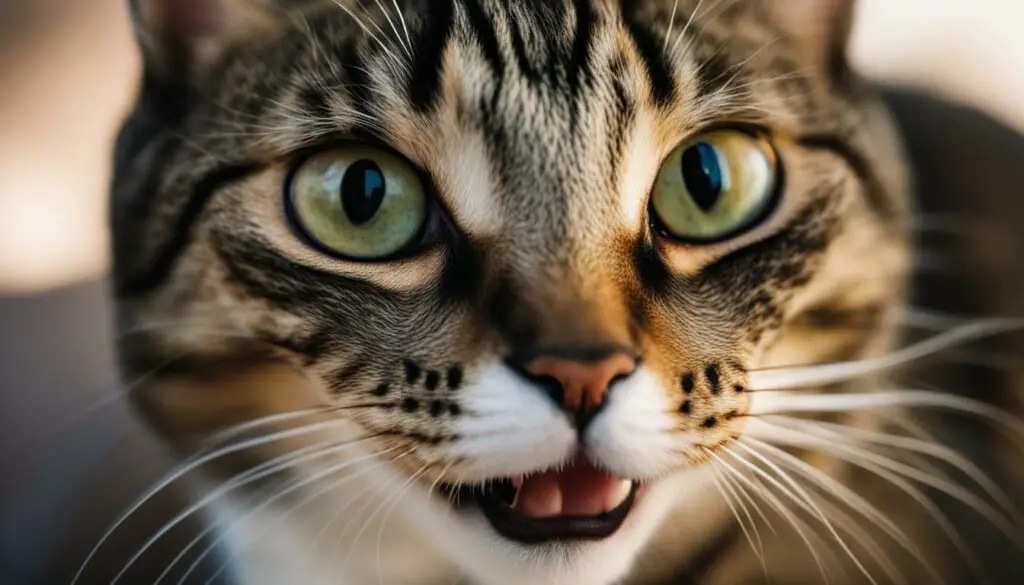As a cat owner, you may have experienced the gentle bite of your feline friend. This seemingly peculiar behavior can leave you wondering why your cat chooses to nip you ever so lightly. The truth is, understanding your cat’s gentle bite is key to strengthening the bond between you and your furry companion.
Cat bites are a form of communication, a unique way in which cats convey their messages and express their needs or boundaries. By deciphering the reasons behind your cat’s biting behavior, you can develop a deeper understanding of their desires and build a harmonious relationship.
Key Takeaways
- Understanding your cat’s gentle bite is crucial for building a strong bond.
- Cat bites serve as a form of communication and can convey various messages.
- Recognize the different reasons why cats bite, such as overstimulation or seeking attention.
- Pay attention to your cat’s body language to gauge their comfort level during petting.
- Provide proper socialization and play opportunities to prevent excessive play biting.
Reasons Why Cats Bite You: Unraveling the Mystery
When it comes to understanding why cats bite, there are a variety of different reasons that can contribute to this behavior. It’s important to recognize the signs and understand what your cat is trying to communicate through their biting behavior.
One common reason for cat biting is overstimulation during petting. Cats can become overwhelmed by excessive petting and may resort to biting as a way to communicate their need for space or a break. It’s important to pay attention to your cat’s body language and recognize signs of discomfort, such as tail twitching or ear flattening.
Territorial behavior is another reason why cats may bite. Cats are naturally territorial animals, and they may bite to defend their territory or establish dominance. Understanding your cat’s territorial boundaries and providing them with a secure and enriched environment can help reduce biting incidents.
Cats may also bite as a way to seek attention. If a cat feels neglected or is craving interaction, they may resort to biting as a way to get your attention. It’s important to provide regular playtime and enrichment activities to fulfill their need for stimulation and prevent attention-seeking biting.
| Reasons Why Cats Bite | Description |
|---|---|
| Overstimulation during petting | Cats may bite when they become overwhelmed by excessive petting. |
| Territorial behavior | Cats may bite to defend their territory or establish dominance. |
| Attention-seeking | Cats may bite to seek attention when they feel neglected. |
Petting-Induced Aggression: When Too Much Petting Becomes a Problem
Petting is often seen as a way to show affection and bond with our cats. However, it’s important to recognize that some cats may experience petting-induced aggression when they are overstimulated. This can lead to biting and other aggressive behaviors, causing distress for both the cat and their caregiver.
How can you tell if your cat is experiencing petting-induced aggression? Look out for subtle signs of overstimulation, such as tail twitching, skin rippling, or the flattening of the ears. These are indications that your cat may be becoming overwhelmed and may resort to biting as a way to cope with the situation.
To prevent petting-induced aggression, it’s crucial to understand your cat’s body language and respect their boundaries. Take note of how your cat responds during petting sessions and be mindful of their comfort level. If you notice any signs of overstimulation, such as those mentioned earlier, it’s important to pause and give your cat a break.
| Signs of Overstimulation in Cats | How to Respond |
|---|---|
| Tail twitching | Stop petting and give your cat space |
| Skin rippling | Move your hand away and let your cat calm down |
| Ear flattening | Cease petting and allow your cat to relax |
Remember, every cat is unique, and their tolerance for petting may vary. By being attentive to their signals and responding appropriately, you can help prevent petting-induced aggression and foster a more harmonious relationship with your feline companion.
How to Pet a Cat Properly: Tips for Gentle Interaction
Petting a cat can be a wonderful way to bond with your feline companion, but it’s important to do it properly to ensure your cat feels comfortable and safe. Understanding your cat’s body language is key to gauging their comfort level and avoiding any potential biting incidents. Here are some tips for gently interacting with your cat:
1. Respect your cat’s boundaries
Every cat has their own preferences when it comes to being petted. Some cats enjoy gentle strokes along their back, while others prefer chin scratches or head rubs. Observe your cat’s reactions and body language to determine their preferred petting style. If your cat starts showing signs of discomfort, such as a flicking tail or flattened ears, it’s best to stop petting and give them some space.
2. Let your cat initiate the interaction
Cats are independent creatures and appreciate having control over their environment. Instead of approaching your cat and forcing them to be petted, try inviting them to interact with you. Extend your hand for a sniff and let your cat approach and rub against it. This allows your cat to feel more comfortable and in control of the interaction.
3. Understand cat body language
Cats communicate through their body language, and being able to read these signals can help you gauge their mood and comfort level. For example, a relaxed and content cat will have a loose body posture, slow blinking eyes, and a softly flicking tail. On the other hand, an agitated or stressed cat may display signs such as a tense body, dilated pupils, and an arched back. By understanding your cat’s body language, you can adjust your petting style accordingly and avoid any potential biting incidents.
| Signs of a Relaxed Cat | Signs of an Agitated Cat |
|---|---|
| Loose body posture | Tense body |
| Slow blinking eyes | Dilated pupils |
| Softly flicking tail | Arched back |
Remember, every cat is unique, and it’s important to pay attention to your cat’s individual preferences and boundaries when petting them. By respecting their boundaries, letting them initiate the interaction, and understanding their body language, you can ensure a positive and enjoyable petting experience for both you and your cat.
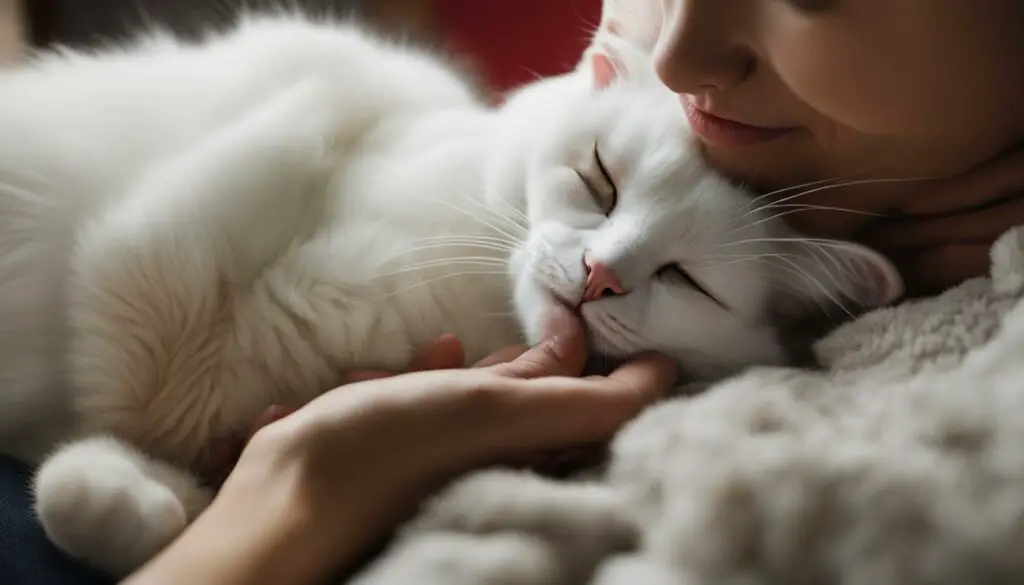
“The way we communicate with cats is through slow, gentle movements. They appreciate our calming presence and gentle touch.”
Play Biting in Cats: Normal Behavior or Cause for Concern?
Play biting is a natural behavior in cats and serves as an essential part of their development. Kittens often engage in play biting with their littermates as a way to learn social skills and establish boundaries. It allows them to practice their hunting instincts and refine their coordination. However, it’s important to understand the difference between normal play biting and aggressive biting.
Early socialization plays a crucial role in preventing excessive play biting in cats. Kittens that have regular interaction with their mother and littermates learn important lessons about bite inhibition and appropriate play behavior. They learn how to control the strength of their bite and understand when their playmate is becoming too rough.
Table: Experiences during early socialization and their impact on play biting behavior
| Early Socialization Experiences | Impact on Play Biting Behavior |
|---|---|
| Regular interaction with mother and littermates | Learn to control bite strength and appropriate play behavior |
| Isolation from mother and littermates | May exhibit excessive play biting and have reduced bite inhibition |
| Early exposure to positive human interaction | Learn to differentiate between play biting and aggression towards humans |
Providing kittens with opportunities for socialization and positive interactions with humans can help prevent the development of aggressive play biting tendencies. Engaging in interactive play sessions using toys that mimic the movement of prey can redirect their natural hunting instincts and provide an appropriate outlet for their energy.
Importance of Early Socialization
Early socialization is crucial in shaping a cat’s behavior and preventing excessive play biting. When kittens are separated from their mother and littermates too early, they miss out on important lessons about bite inhibition, communication, and social skills. As a result, they may be more prone to aggressive play biting as adults.
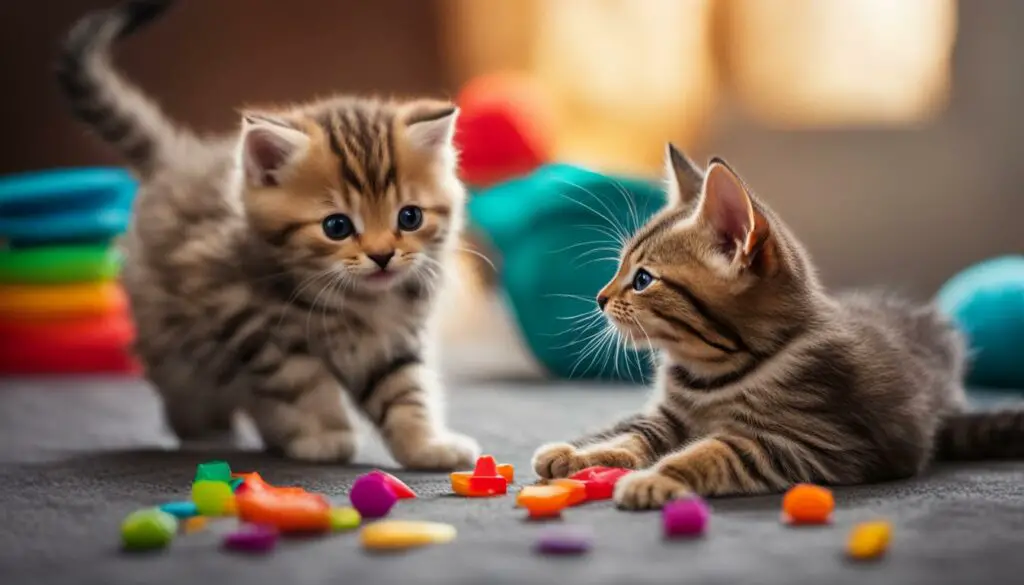
By understanding the importance of early socialization and providing kittens with positive experiences, we can help them develop into well-adjusted adult cats with appropriate play behavior. Ensuring a safe and stimulating environment, regular interaction with humans and other animals, and positive reinforcement training can all contribute to reducing the risk of play biting becoming a cause for concern.
Love Bites from Your Cat: Understanding Gentle Nibbling
When it comes to our feline friends, love can sometimes come in the form of gentle nibbling. Cats engage in a behavior known as allogrooming, which involves using their mouths to groom their human companions. These love bites are often light and accompanied by purring and kneading, demonstrating a sense of affection and bonding.
Allogrooming is a natural behavior for cats, reminiscent of how they groom each other in social groups. It’s their way of showing trust and strengthening their bond with their human family members. While these love bites may be endearing, it’s essential to distinguish them from aggressive biting.
To determine if a bite is a love bite or a sign of aggression, consider the context and overall behavior of your cat. Love bites are usually gentle and accompanied by relaxed body language, whereas aggressive bites are forceful and may be accompanied by signs of agitation or fear. If your cat’s biting behavior becomes aggressive or related to petting intolerance, it’s necessary to address the issue and seek appropriate guidance.
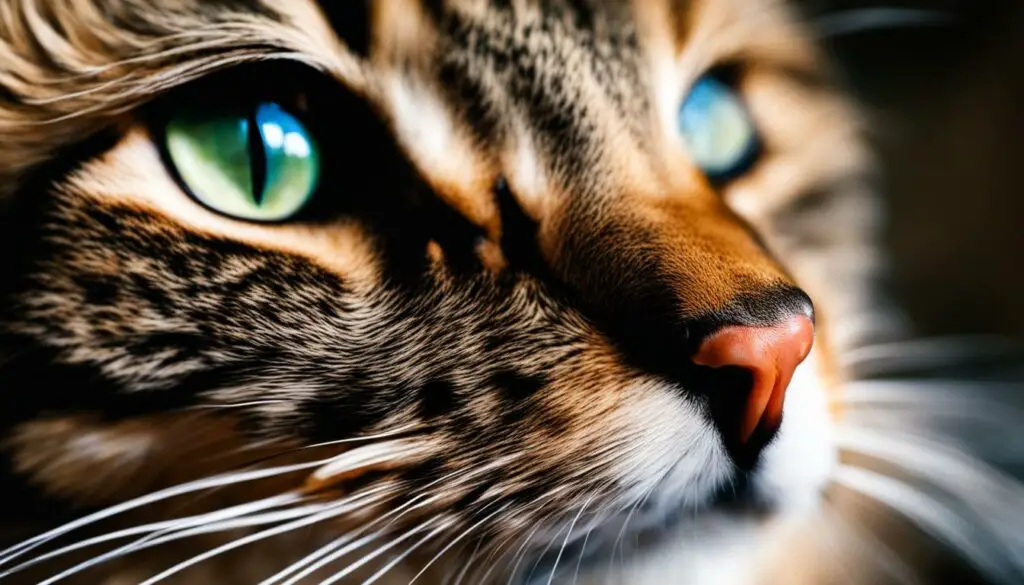
Understanding the Difference: Love Bites vs. Aggressive Biting
Love bites from cats occur during moments of bonding and affection. They are typically soft, controlled, and non-threatening, without any signs of fear or discomfort. Cats might gently nibble on your hand or arm while purring, showing their trust and contentment.
Love bites are a way for cats to express their love and affection, similar to how they would groom their fellow feline companions. It’s their way of saying, “I love you!”
On the other hand, aggressive biting often involves forceful, intense bites accompanied by hissing or growling. These bites are born out of fear, pain, or a sense of being threatened. Aggressive biting should be taken seriously and addressed promptly to ensure the safety and well-being of both the cat and their human companions.
Building a Strong Bond: Nurturing Love Bites
If your cat’s love bites are a welcome part of your relationship, it’s important to nurture this behavior in a positive and healthy way. Encourage gentle nibbling during bonding sessions by providing your cat with appropriate grooming tools, such as a soft brush or grooming mitt. This can redirect their grooming behavior and help prevent accidental nips.
Additionally, always be attentive to your cat’s body language and boundaries. If they show signs of discomfort or if the love bites become too intense, gently redirect their behavior with a favorite toy or engage them in interactive play. This not only strengthens your bond but also provides an outlet for their natural instincts.
Fear Aggression: Biting as a Defensive Response
Some cats may exhibit fear aggression, biting as a defensive response when they feel threatened or afraid. Fear-based biting is typically a reaction to a perceived danger, and it can occur in various situations, such as encountering unfamiliar people, animals, or loud noises.
Recognizing the signs of fear-based biting is essential in understanding and addressing this behavior. Some common indicators include flattened ears, dilated pupils, raised fur along the back, growling or hissing, and a crouched or defensive body posture. These signs serve as a warning that your cat is feeling frightened or anxious, and biting becomes their way of protecting themselves.
When dealing with fear aggression in cats, it’s crucial to create a safe and secure environment for your furry friend. Provide hiding spots, such as cat trees or covered beds, where they can retreat when feeling scared. Additionally, avoid exposing your cat to situations or stimuli that trigger their fear-based biting. Gradual desensitization and positive reinforcement techniques can help them become more comfortable and confident over time.
Recognizing Signs of Fear-Based Biting
Signs of fear-based biting may vary from cat to cat, but here are some common behaviors to watch for:
- Flattened ears
- Dilated pupils
- Raised fur along the back
- Growling or hissing
- Crouched or defensive body posture
Creating a Safe Environment
To help prevent fear-based biting, consider implementing the following measures:
- Provide hiding spots, such as cat trees or covered beds.
- Avoid exposing your cat to situations or stimuli that trigger fear.
- Practice gradual desensitization to help your cat become more comfortable.
- Use positive reinforcement techniques to build their confidence.
Seeking Professional Assistance
If fear-based biting persists or becomes severe, it may be beneficial to seek professional help from a veterinarian or a certified cat behaviorist. They can provide expert guidance and develop a comprehensive behavior modification plan tailored to your cat’s specific needs. Remember, patience and consistency are key when working with fear aggression, and with the right support, your cat can learn to overcome their fears and form a more harmonious bond with you.
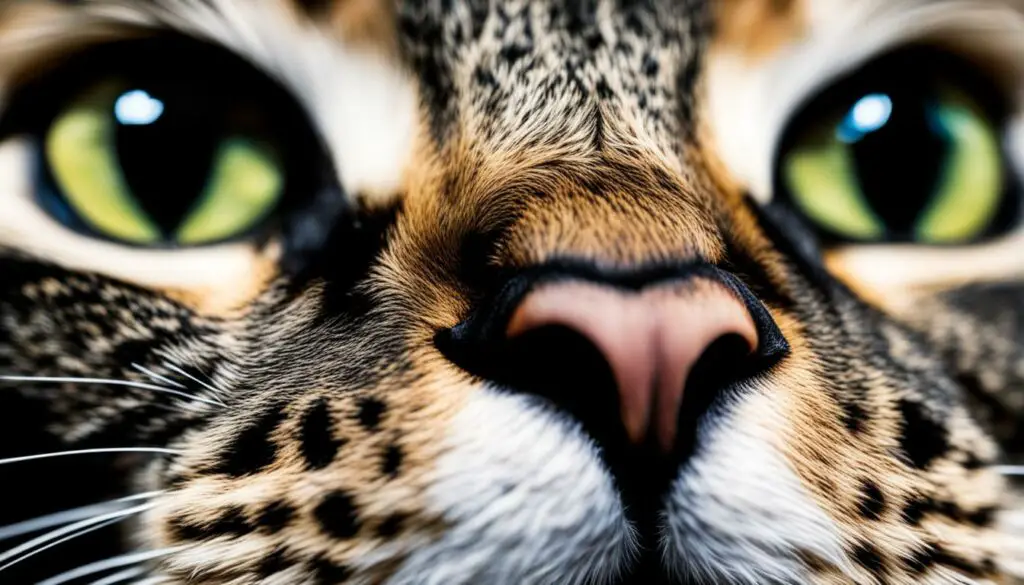
Responding to Cat Bites: Calm and Positive Reinforcement
When your cat bites, it’s important to respond calmly and avoid aggressive reactions. Retracting your hand gently and redirecting your cat’s attention to toys or other positive stimuli can help discourage biting behavior. Punishing your cat for biting can lead to fear and further aggression, so it’s best to focus on positive reinforcement.
Redirecting your cat’s biting behavior can be achieved by providing appropriate alternatives. Offer interactive toys and engage in play sessions to redirect their energy and fulfill their natural hunting instincts. This not only provides a positive outlet for their biting tendencies but also helps strengthen the bond between you and your cat.
Another effective way to respond to cat bites is to establish clear boundaries. If your cat tends to bite during certain situations, such as while being petted excessively, pay attention to their body language. Look for signs of discomfort, such as twitching tail or flattened ears, and respect their limits. This may involve reducing the duration of petting sessions or finding alternative ways to bond, such as brushing or gentle massages.
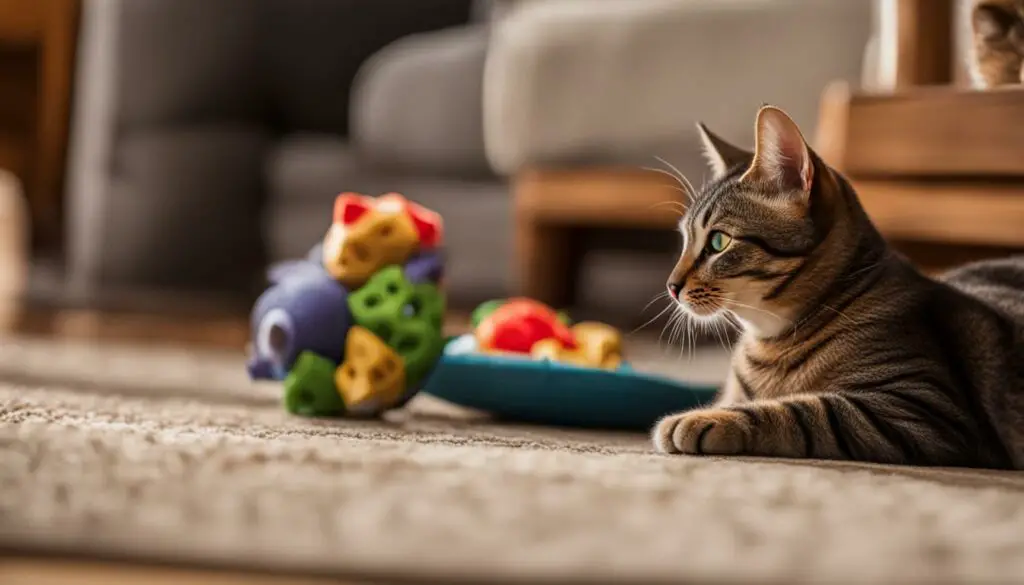
Redirecting Biting Behavior: A Step-by-Step Guide
- Stay calm and avoid reacting aggressively when bitten by your cat.
- Slowly retract your hand or remove it from the biting area without jerking away.
- Redirect your cat’s attention to a toy, such as a feather wand or a crinkly ball.
- Engage your cat in play and reward them with praise or treats for interacting with the toy instead of biting.
- If the biting behavior persists, consider seeking professional help from a cat behaviorist or trainer for additional guidance.
“Redirecting your cat’s attention to toys or other positive stimuli can help discourage biting behavior.” – Cat Behavior Expert
Training and Behavior Modification: Helping Your Cat Overcome Biting
If your cat’s biting behavior has become a serious issue, seeking professional help from a cat behaviorist or trainer may be the best course of action. These experts have the knowledge and experience to assess your cat’s behavior and provide tailored solutions to help them overcome biting tendencies.
A cat behaviorist or trainer can work with you to develop a behavior modification plan that addresses the root causes of your cat’s biting. They will take into consideration factors such as your cat’s temperament, past experiences, and the specific triggers for their biting behavior. Through reward-based training methods and positive reinforcement, they can help your cat learn alternative behaviors and appropriate ways to communicate their needs, reducing the frequency and intensity of their biting.
It’s important to note that behavior modification takes time and consistency. Your cat’s progress may be gradual, and setbacks can occur along the way. However, with patience and commitment to the training plan, you can help your cat overcome their biting habits and foster a healthier and happier relationship.
Remember, training and behavior modification should always be done using positive reinforcement techniques. Punishing or scolding your cat for biting will only create fear and may exacerbate their aggressive behavior. By working with a professional who understands feline behavior and using reward-based methods, you can create a safe and nurturing environment for your cat to learn and grow.
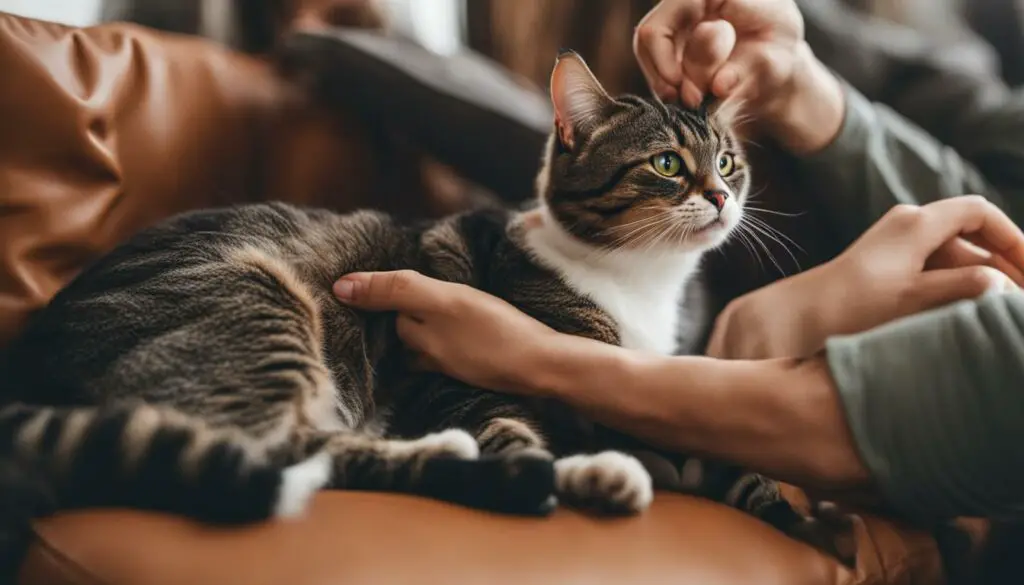
Example: Behavior Modification Plan
Here’s an example of a behavior modification plan that a cat behaviorist may recommend to help address biting behavior:
| Step | Strategy |
|---|---|
| 1 | Identify triggers and establish boundaries |
| 2 | Redirect biting behavior to appropriate toys or objects |
| 3 | Replace biting with positive alternative behaviors, such as gentle play or grooming sessions |
| 4 | Provide environmental enrichment to keep your cat mentally stimulated and reduce stress |
| 5 | Consistently reinforce positive behaviors with rewards, such as treats or praise |
By following a behavior modification plan like this, you can gradually reshape your cat’s behavior and help them develop healthier ways to communicate and interact with you and their environment.
Build a Strong Bond: Alternative Ways to Connect with Your Cat
While physical affection is a common way to bond with our cats, it’s important to remember that not all cats enjoy being petted or cuddled. If your cat’s gentle bites during petting sessions or physical contact trigger discomfort or aggression, there are alternative ways to build a strong bond and connect with them.
Interactive play sessions can be an excellent way to engage with your cat. Use toys such as feather wands or laser pointers to stimulate their natural hunting instincts. These interactive sessions provide mental and physical stimulation, allowing your cat to release pent-up energy and bond with you through play.
Providing environmental enrichment is another effective method to connect with your cat. Create a stimulating environment by offering scratching posts, climbing trees, puzzle toys, and hiding spots. This not only keeps your cat physically active but also provides them with a sense of security and ownership over their territory.
Finally, creating a safe and comfortable space for your cat allows them to feel secure and build trust. Designate a quiet corner or a cozy cat bed where your cat can retreat to when they want privacy. Respect their need for personal space and allow them to approach you when they feel comfortable.
Remember, every cat is unique, and finding alternative ways to bond and connect requires patience and understanding. By exploring these alternative interactions, you can strengthen your bond with your cat and foster a loving relationship based on trust and mutual respect.

| Alternative Ways to Connect with Your Cat | Benefits |
|---|---|
| Interactive play sessions | – Stimulates hunting instincts – Provides mental and physical stimulation – Enhances the bond through shared activity |
| Providing environmental enrichment | – Keeps your cat physically active – Provides a sense of security and ownership – Promotes exploration and engagement |
| Creating a safe and comfortable space | – Allows your cat to feel secure – Respects their need for personal space – Builds trust and reduces stress |
Cat Bite Safety: Taking Care of Bites and Wounds
While cat bites can be a common occurrence in our interactions with our feline companions, it’s essential to take proper care of these bites to prevent infection and promote healing. Treating cat bites and ensuring proper wound care is crucial for both our own well-being and the well-being of our cats.
When you get bitten by a cat, the first step is to clean the wound thoroughly with mild soap and warm water. Gently wash around the bite area, ensuring that all dirt and bacteria are removed. Pat the wound dry with a clean towel and apply an antibiotic ointment to help prevent infection. It’s important to cover the bite with a clean dressing, such as a sterile gauze pad, to protect it from further contamination.
If the cat bite shows signs of infection, such as increased redness, swelling, warmth, or discharge, it’s crucial to seek medical attention. Your healthcare provider may prescribe oral antibiotics to treat the infection effectively. Additionally, if the bite is deep, gaping, or doesn’t stop bleeding, it’s important to seek prompt medical care to ensure proper wound closure and prevent complications.
| Symptoms of infected cat bites | When to seek medical attention |
|---|---|
| Fever | If the bite is deep or doesn’t stop bleeding |
| Increased redness, swelling, or warmth around the bite | If the bite shows signs of infection |
| Pus or discharge from the wound | If there is severe pain or difficulty moving the affected area |
It’s important to remember that cat bites can introduce bacteria deep into the skin layers, and prompt care is necessary to prevent the development of serious infections such as cellulitis or abscesses. By taking proper care of cat bites and seeking medical attention when needed, we can ensure a safe and healthy healing process for ourselves and our beloved feline companions.
Understanding Feline Communication: Body Language and Vocal Cues
When it comes to understanding our feline companions, deciphering their body language and vocal cues is key. Cats have a unique way of expressing themselves, and by paying attention to their subtle signals, we can gain valuable insights into their mood, comfort level, and needs.
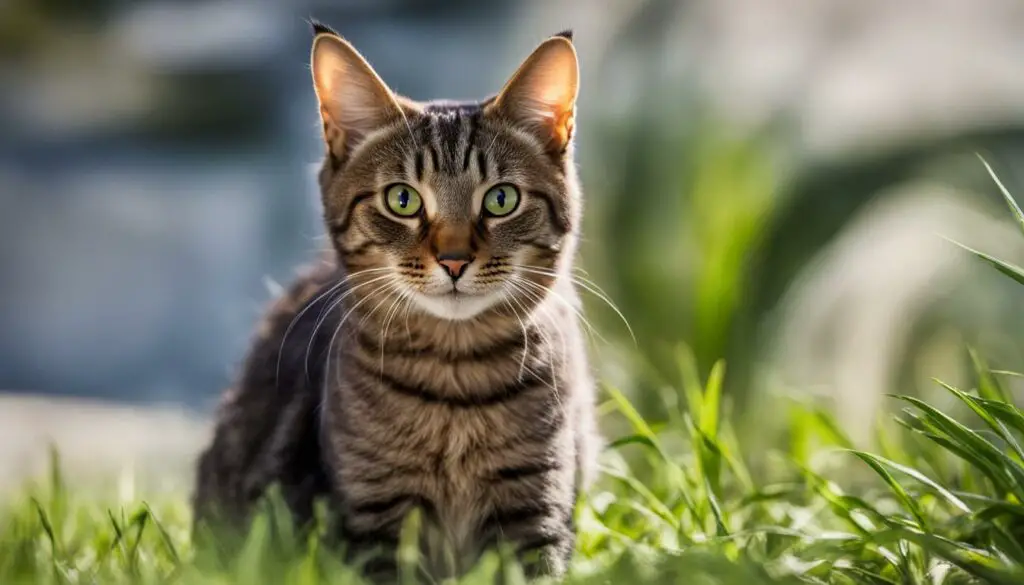
Cat body language involves various aspects, such as tail position, ear orientation, and facial expressions. For example, a relaxed and upright tail typically indicates that a cat is content and comfortable. On the other hand, a tail held low or tucked between the legs may indicate fear or anxiety. Similarly, ears held forward and slightly to the side often signal curiosity, while flattened ears can indicate aggression or discomfort.
Vocal cues also play a significant role in feline communication. Cats use different types of vocalizations to express their needs and emotions. A soft purr typically signifies contentment and relaxation, while a loud and prolonged meow often indicates hunger or a desire for attention. Hissing or growling, on the other hand, are vocalizations that cats may use when they feel threatened or defensive.
Understanding Cat Body Language:
To help you interpret your cat’s body language accurately, here are a few key signals to look out for:
- Tail position: Pay attention to the position and movement of your cat’s tail. A relaxed and erect tail generally indicates a content and comfortable cat, while a tail held low or tucked between the legs may suggest fear or anxiety.
- Ear orientation: Observe your cat’s ear position. Forward-facing ears often signal curiosity, while flattened ears may indicate aggression or discomfort.
- Facial expressions: Cats use facial expressions to communicate their emotions. Relaxed eyes and a slightly open mouth typically signify a calm and content cat, while dilated pupils and a tense facial expression may indicate fear or aggression.
“Understanding your cat’s body language can help you respond appropriately to their needs and ensure a harmonious relationship.”
It’s important to remember that each cat is unique, and individual personality traits can influence their communication style. By observing your cat’s body language and vocal cues, you can deepen your understanding of their emotions and build a stronger bond based on trust and mutual understanding.
The Role of Socialization in Biting Behavior: Early Experiences Matter
Proper socialization plays a crucial role in shaping a cat’s behavior, including their response to petting and biting tendencies. Early experiences during the critical socialization period, which typically occurs between 2 to 7 weeks of age, can significantly influence a cat’s aggression risk and overall temperament.
During this period, kittens learn how to interact with other cats and their environment, developing essential social and communication skills. When kittens are separated from their mother and littermates too early, they miss out on crucial lessons in bite inhibition and appropriate play behavior. This can lead to increased aggression as adults, as they may not have learned the necessary skills to communicate their needs effectively.
A study conducted by Dr. Rachel Casey at the Bristol Cats Protection and the School of Veterinary Sciences found that kittens weaned before 8 weeks old were more likely to show aggressive behaviors, including biting, in comparison to those weaned at a later age. The research highlighted the importance of allowing kittens to stay with their mother and littermates until at least 8 weeks old to ensure proper socialization and reduce the risk of aggression.
| Age of Weaning | Aggression Risk | Recommended Weaning Age |
|---|---|---|
| 6 weeks | High | 8 weeks or later |
| 8 weeks | Medium | N/A |
| 10 weeks | Low | N/A |
This table illustrates the relationship between the age of weaning and the associated aggression risk. As the age of weaning decreases, the likelihood of aggression increases. To minimize the risk of biting behavior and promote a well-adjusted cat, it is recommended to keep kittens with their mother and littermates until at least 8 weeks old.
By focusing on proper socialization and ensuring kittens have a sufficient weaning age, cat owners can contribute to reducing aggression and potential biting behavior in their feline companions. Early experiences play a critical role in shaping a cat’s behavior, emphasizing the importance of providing a nurturing and enriching environment during this crucial period.
Conclusion
Understanding your cat’s gentle bite and the reasons behind their biting behavior is essential for building a strong and loving bond with your feline companion. Cats use gentle biting as a form of communication, expressing their needs and boundaries. By recognizing their cues and respecting their comfort levels, you can create a harmonious relationship.
It’s important to distinguish between different types of biting, such as petting-induced aggression, play biting, and love bites. Each has its own underlying reasons and requires specific approaches for addressing them. Paying attention to your cat’s body language, including tail position and ear orientation, can help you gauge their comfort level during interactions.
If your cat exhibits biting behavior that is causing concern or becomes aggressive, seeking professional assistance from a cat behaviorist or trainer can be beneficial. They can provide guidance on behavior modification techniques and help address any underlying issues contributing to the biting tendencies.
Remember, bonding with your cat goes beyond physical affection. Engaging in interactive play sessions, providing environmental enrichment, and creating a safe and comfortable space for your cat are alternative ways to build a strong connection. By understanding their communication, respecting their boundaries, and reinforcing positive behaviors, you can create a loving and fulfilling relationship with your cat.
FAQ
Why do cats bite?
Cats may bite for various reasons, including overstimulation during petting, territorial behavior, attention-seeking, or as a form of communication.
How can I prevent petting-induced aggression in my cat?
To prevent petting-induced aggression, it’s important to recognize your cat’s body language and respect their boundaries. Pay attention to signs of discomfort, such as tail twitching or ear flattening, and let your cat control the petting session.
Is play biting in cats normal?
Play biting is normal behavior in cats, but it may become problematic if not properly addressed during early socialization. Providing proper socialization and play opportunities can help prevent excessive play biting.
What is the difference between love bites and aggressive biting?
Love bites are gentle nibbles that cats use as part of their grooming behavior to reinforce their bond with their human companions. Aggressive biting, on the other hand, is not considered a gentle bite and may be related to fear or defensive responses.
How should I respond when my cat bites me?
When your cat bites, it’s important to remain calm and avoid aggressive reactions. Gently retract your hand and redirect your cat’s attention to toys or other positive stimuli. Punishing your cat for biting may lead to fear and further aggression.
What should I do if my cat’s biting behavior becomes a serious issue?
If your cat’s biting behavior becomes a serious issue, it’s advisable to seek professional help from a cat behaviorist or trainer. They can provide guidance on behavior modification techniques and help address any underlying issues contributing to the biting behavior.
How can I strengthen my bond with my cat without relying solely on physical affection?
If petting and physical contact trigger biting in your cat, consider alternative ways to bond, such as interactive play sessions, providing environmental enrichment, and creating a safe and comfortable space for your cat.
What should I do if I get bitten by my cat?
If you get bitten by your cat, it’s important to take proper care of the wound to prevent infection. Clean the wound thoroughly, apply antibiotic ointment, and cover it with a dressing. Seek medical attention if the bite shows signs of infection or if the wound becomes severe.
How can I understand my cat’s communication cues?
Understanding your cat’s body language and vocal cues is crucial in interpreting their behavior and communication. Pay attention to tail position, ear orientation, facial expressions, and vocalizations to gain insights into your cat’s mood, comfort level, and needs.
How does early socialization affect a cat’s biting behavior?
Early socialization plays a significant role in shaping a cat’s behavior, including their response to petting and biting tendencies. Kittens separated from their mother and littermates too early may experience increased aggression as adults. Ensuring proper socialization and a sufficient weaning age can help prevent aggressive biting behavior.

